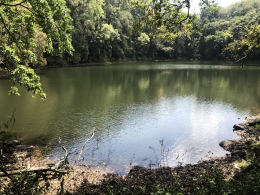High in the cold, jagged spine of the Himalayas, where cliffs drop into shadowed gorges and snowfields stretch endlessly beneath piercing blue skies, roams a creature as rare as it is revered—the snow leopard (Panthera uncia). Seldom seen, yet central to mountain folklore, this elusive predator has earned its chilling nickname: “The Ghost of the Himalayas.”
In Bhutan, where myth and wilderness still walk side by side, the snow leopard is more than a biological wonder—it is a symbol of both fragility and strength in the face of a changing world.
Elusive Predator of the Peaks
The snow leopard’s preferred habitat lies above 3,000 to 5,500 meters, where barren rock faces and treeless ridgelines provide the perfect camouflage for a master hunter. Its thick smoky-grey coat, dappled with dark rosettes, blends seamlessly into the scree-covered slopes of the Eastern Himalayas. With strong limbs, a long tail for balance, and padded feet adapted for snowy terrain, the snow leopard is built for life on the edge—physically and ecologically.

Ghost of the Himalayas
Bhutan is home to a significant portion of the snow leopard’s global population, which is estimated to be between 3,500 and 7,000 individuals worldwide. The exact numbers remain uncertain due to the animal’s elusive nature, but annual camera trap surveys and genetic sampling carried out by the Department of Forests and Park Services (DoFPS) have shown promising signs of survival and even stability.
The most recent nationwide snow leopard survey, conducted in collaboration with conservation partners, recorded a minimum of 134 individuals across protected areas including Wangchuck Centennial National Park, Jigme Dorji National Park, and Bumdeling Wildlife Sanctuary. These high-altitude refuges are crucial for the snow leopard’s future—not just in Bhutan, but across its global range.
Why the Ghost?
To locals and trekkers alike, the snow leopard’s ghostly reputation is well-earned. Unlike tigers or leopards, which often leave pugmarks and trails, snow leopards leave behind only whispers — a scrape on a rock, a faded pawprint in the snow, or the remains of a blue sheep kill dragged beneath a boulder.
They are rarely seen in the wild, even by seasoned herders who have spent decades in the highlands. Their solitary and wide-ranging nature, often patrolling territories as large as 100 square kilometers, ensures that most sightings come only through camera traps. This silence, this invisibility, has given rise to the name “Ghost of the Himalayas.”
Myths and Mountain Beliefs
Among the highlanders, particularly the Layaps, Lunaps, and Brokpas, the snow leopard holds a deep, almost sacred place in the cultural imagination. Some believe the animal to be a mountain deity in disguise, a guardian of hidden treasures and sacred lakes. Others see it as a messenger between worlds, appearing only to those pure of heart or touched by the spiritual.
Because of this, communities have long practiced tolerance—even reverence—despite the occasional livestock predation. Traditionally, conflicts were resolved through compensation, rituals, or invoking local deities, rather than retaliation. Such cultural beliefs have greatly helped conservation efforts.
Conservation Challenges and Hope
Despite its mythical status, the snow leopard is classified as “Vulnerable” by the IUCN. Bhutan’s population remains under pressure from climate change, habitat fragmentation, retaliatory killings, and competition with expanding livestock herds.
As warming temperatures shrink alpine ecosystems, snow leopards are being forced to higher, narrower ridgelines. Simultaneously, their prey—blue sheep and Himalayan tahr—decline under increasing grazing pressure, forcing leopards closer to human settlements in search of food.

To mitigate these threats, the government has taken several bold steps. Through the Snow Leopard Conservation Program and with the support of global partners like WWF and the Snow Leopard Trust, rangers and conservationists now monitor known territories with camera traps, track movement through GPS collars, and work closely with communities to reduce conflict.
A Silent Sentinel of the Sacred Peaks
In many ways, the snow leopard’s survival is tied to more than science or policy; it’s bound to Bhutan’s own ethos of harmony between humans and nature. In a nation where Gross National Happiness values ecology as much as economy, the snow leopard remains a symbol of balance—between the spiritual and the wild, the seen and the unseen.
As long as the high passes echo with wind and prayer flags flutter beneath glaciers, the ghost of the Himalayas will roam. Not merely as a rare predator, but as a living embodiment of Bhutan’s commitment to protect the mysteries—and majesty—of its sacred mountains.








